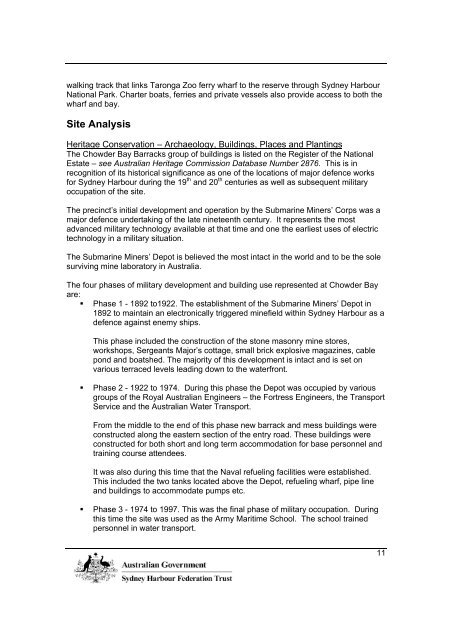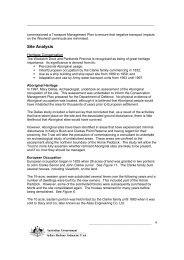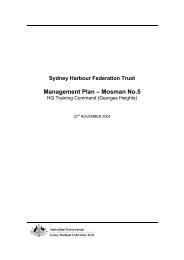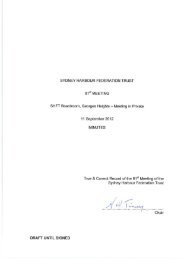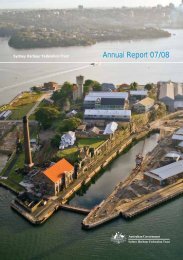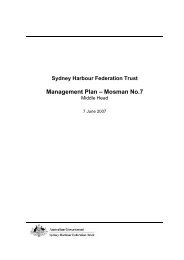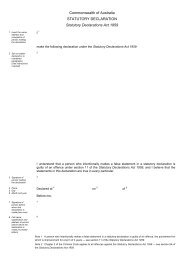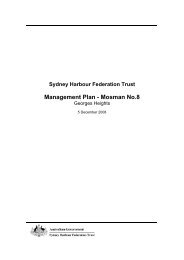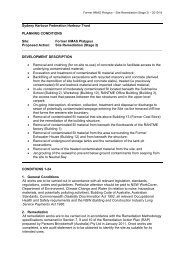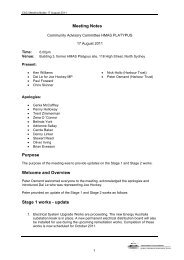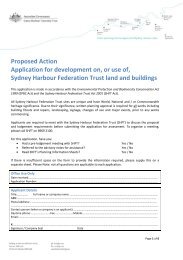Management Plan - Chowder Bay, Part 2 (PDF - 1.26 MB) - Sydney ...
Management Plan - Chowder Bay, Part 2 (PDF - 1.26 MB) - Sydney ...
Management Plan - Chowder Bay, Part 2 (PDF - 1.26 MB) - Sydney ...
You also want an ePaper? Increase the reach of your titles
YUMPU automatically turns print PDFs into web optimized ePapers that Google loves.
walking track that links Taronga Zoo ferry wharf to the reserve through <strong>Sydney</strong> Harbour<br />
National Park. Charter boats, ferries and private vessels also provide access to both the<br />
wharf and bay.<br />
Site Analysis<br />
Heritage Conservation – Archaeology, Buildings, Places and <strong>Plan</strong>tings<br />
The <strong>Chowder</strong> <strong>Bay</strong> Barracks group of buildings is listed on the Register of the National<br />
Estate – see Australian Heritage Commission Database Number 2876. This is in<br />
recognition of its historical significance as one of the locations of major defence works<br />
for <strong>Sydney</strong> Harbour during the 19 th and 20 th centuries as well as subsequent military<br />
occupation of the site.<br />
The precinct’s initial development and operation by the Submarine Miners’ Corps was a<br />
major defence undertaking of the late nineteenth century. It represents the most<br />
advanced military technology available at that time and one the earliest uses of electric<br />
technology in a military situation.<br />
The Submarine Miners’ Depot is believed the most intact in the world and to be the sole<br />
surviving mine laboratory in Australia.<br />
The four phases of military development and building use represented at <strong>Chowder</strong> <strong>Bay</strong><br />
are:<br />
• Phase 1 - 1892 to1922. The establishment of the Submarine Miners’ Depot in<br />
1892 to maintain an electronically triggered minefield within <strong>Sydney</strong> Harbour as a<br />
defence against enemy ships.<br />
This phase included the construction of the stone masonry mine stores,<br />
workshops, Sergeants Major’s cottage, small brick explosive magazines, cable<br />
pond and boatshed. The majority of this development is intact and is set on<br />
various terraced levels leading down to the waterfront.<br />
• Phase 2 - 1922 to 1974. During this phase the Depot was occupied by various<br />
groups of the Royal Australian Engineers – the Fortress Engineers, the Transport<br />
Service and the Australian Water Transport.<br />
From the middle to the end of this phase new barrack and mess buildings were<br />
constructed along the eastern section of the entry road. These buildings were<br />
constructed for both short and long term accommodation for base personnel and<br />
training course attendees.<br />
It was also during this time that the Naval refueling facilities were established.<br />
This included the two tanks located above the Depot, refueling wharf, pipe line<br />
and buildings to accommodate pumps etc.<br />
• Phase 3 - 1974 to 1997. This was the final phase of military occupation. During<br />
this time the site was used as the Army Maritime School. The school trained<br />
personnel in water transport.<br />
11


